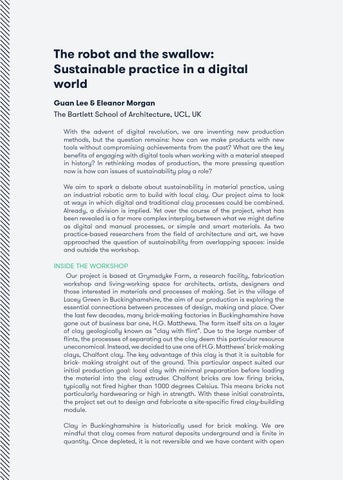The robot and the swallow: Sustainable practice in a digital world Guan Lee & Eleanor Morgan The Bartlett School of Architecture, UCL, UK With the advent of digital revolution, we are inventing new production methods, but the question remains: how can we make products with new tools without compromising achievements from the past? What are the key benefits of engaging with digital tools when working with a material steeped in history? In rethinking modes of production, the more pressing question now is how can issues of sustainability play a role? We aim to spark a debate about sustainability in material practice, using an industrial robotic arm to build with local clay. Our project aims to look at ways in which digital and traditional clay processes could be combined. Already, a division is implied. Yet over the course of the project, what has been revealed is a far more complex interplay between what we might define as digital and manual processes, or simple and smart materials. As two practice-based researchers from the field of architecture and art, we have approached the question of sustainability from overlapping spaces: inside and outside the workshop.
INSIDE THE WORKSHOP Our project is based at Grymsdyke Farm, a research facility, fabrication workshop and living-working space for architects, artists, designers and those interested in materials and processes of making. Set in the village of Lacey Green in Buckinghamshire, the aim of our production is exploring the essential connections between processes of design, making and place. Over the last few decades, many brick-making factories in Buckinghamshire have gone out of business bar one, H.G. Matthews. The farm itself sits on a layer of clay geologically known as “clay with flint”. Due to the large number of flints, the processes of separating out the clay deem this particular resource uneconomical. Instead, we decided to use one of H.G. Matthews’ brick-making clays, Chalfont clay. The key advantage of this clay is that it is suitable for brick- making straight out of the ground. This particular aspect suited our initial production goal: local clay with minimal preparation before loading the material into the clay extruder. Chalfont bricks are low firing bricks, typically not fired higher than 1000 degrees Celsius. This means bricks not particularly hardwearing or high in strength. With these initial constraints, the project set out to design and fabricate a site-specific fired clay-building module. Clay in Buckinghamshire is historically used for brick making. We are mindful that clay comes from natural deposits underground and is finite in quantity. Once depleted, it is not reversible and we have content with open
